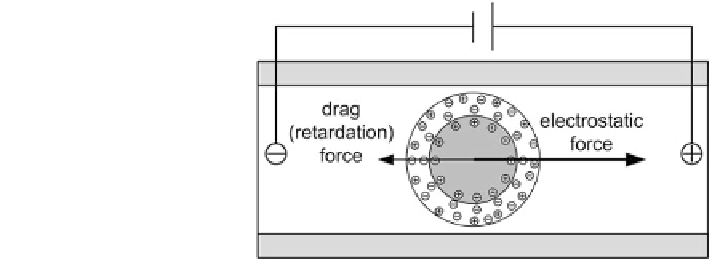Environmental Engineering Reference
In-Depth Information
Fig. 6.19 The electrophoretic
flow of a charged particle
6.4.1.2 Electrophoresis and Dielectrophoresis
Electrophoresis relates to the manipulation of charged particles or molecules by the
application of an electric
eld [
90
,
97
,
98
]. The
fl
uids in this case can be various
electrolytes, dielectric
uids, etc.
In the case of Fig.
6.19
, a charged particle is immersed in the electrolyte. Around
this particle a local
fl
eld is created. As a result, a double electric layer (EDL, see
also Electroosmosis) is created. The in
eld on a
particular particle will lead to two forces acting on the particle: the electrostatic
force, which pulls the particle towards the positive electrode; and the friction (drag)
force, which is a consequence of the movement of the particle through the viscous
liquid [
90
,
97
].
In practice, capillary electrophoresis, which is mostly used as a separation
technique, is often applied for the separation of ionized molecules.
Dielectrophoresis is similar to electrophoresis; however, in this case the polar-
izable (neutral) particles are immersed in an electrolyte. When a non-uniform
electric
fl
uence of the applied electric
eld is applied, the dielectrophoretic force is established. Similar to the
situation with electrophoresis, a viscous drag force will also act on the particle [
90
,
99
,
100
]. Figure
6.20
shows three different examples of an electric
eld acting on a
polarizable particle.
In the case of Fig.
6.20
a, a uniform electric eld is established over the particle.
Therefore, the net force on such a particle will lead to no movement. In the case that
the
uid in which the neutral particle is immersed has a higher polarization than the
particle itself, the net force will act on the particles in such a way that they will
migrate towards the region with the lowest electric
fl
eld (Fig.
6.20
b). Figure
6.20
c
shows an example of positive dielectrophoresis, in which a neutral particle is
immersed in a less polarizable
uid (than the polarization of the particle) or vac-
uum. In this case, the particles will migrate towards the region where the electric
fl
eld is the highest, i.e. towards the electrodes.
Electrophoresis and dielectrophoresis, as principles, do not have a great potential
in applications as a thermal diode mechanism in magnetic refrigeration. More
interesting, perhaps, is the domain of electroosmosis and related
fl
uid
fl
ow, which is
presented in the following subsection.

Search WWH ::

Custom Search